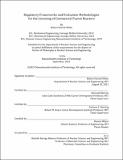Regulatory Frameworks and Evaluation Methodologies for the Licensing of Commercial Fusion Reactors
Author(s)
White, Robert Patrick
DownloadThesis PDF (11.65Mb)
Advisor
Shirvan, Korush
Hartwig, Zachary S.
Terms of use
Metadata
Show full item recordAbstract
Private companies hoping to deploy commercial fusion facilities in the next two decades will encounter a variety of technical, social, and economic challenges. These companies will also need to assess and develop appropriate technology regulation.
The under-regulation, over-regulation, or mis-regulation of a new technology could jeopardize long-term commercial deployment opportunities. Timely assessment and development of appropriate regulatory requirements are critical to the success of commercial fusion technology in the next two decades. The assessment and development of regulatory requirements for new technologies, however, is often based prior on operating experience or regulation of similar technologies. The applicability of these assessment and development methods is restricted for commercial fusion facilities for a variety of factors including the wide variety of fusion technologies currently under development, the preliminary nature of commercial design efforts, and the limited characterization of commercial fusion facility concept of operations.
This work presents an initial comprehensive approach to the assessment and development of appropriate regulatory requirements for commercial fusion technology. Models and methods based on the fundamental hazards of a technology are utilized to help examine the licensing and regulation of novel technologies and provide insights on how to more effectively assess and develop regulatory requirements. The different licensing evaluation methods and regulatory frameworks are developed and presented to provide insights on the impact of these regulatory decisions on the design constraints and regulatory burden for commercial fusion technology.
Specific insights are given on the selection of licensing evaluation methods and regulatory framework from this work. Licensing evaluation related insights include the incompatibility of large tritium inventories with low regulatory burden licensing evaluation methods, the design benefits and regulatory burden drawbacks of crediting engineering safety features in the licensing of fusion facilities, and potential advantages of utilizing System Theoretical Process Analysis (STPA) in the development of operational requirement for novel, complex systems such as commercial fusion. Regulatory framework related insights include the potential applicability of a delegated review regulatory framework (similar to commercial aviation) to commercial fusion, the potential economic costs of a new minimal regulation system based on a new strict liability insurance framework, and the development advantages of a new cooperative operational characterization regulatory framework for novel technologies such as commercial fusion.
The methods and models described in this work are intended to help regulators and industry evaluate the hazards of commercial fusion facilities and select licensing evaluation methods and regulatory frameworks that satisfy the social and economic constraints on commercial fusion facilities. Regulation is often viewed as inhibiting innovation but the proactive development of regulatory requirements using a comprehensive hazard based approach can help maintain social license for fusion technology, facilitate safe operation, and create a stable regulatory environment that will help foster the successful commercial development and deployment of fusion facilities for clean energy production.
Date issued
2021-09Department
Massachusetts Institute of Technology. Department of Nuclear Science and EngineeringPublisher
Massachusetts Institute of Technology